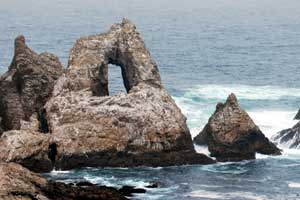 Our trip to the Farallon Islands was certainly eventful: seasickness (me), bug bites (me) and immersion in one of the most unique wildlife habitats in the world (which made it all worth it). This chain of windblown rocks, about 27 miles from San Francisco, is teeming with 300,000 seabirds in the spring and summer.
Our trip to the Farallon Islands was certainly eventful: seasickness (me), bug bites (me) and immersion in one of the most unique wildlife habitats in the world (which made it all worth it). This chain of windblown rocks, about 27 miles from San Francisco, is teeming with 300,000 seabirds in the spring and summer.
The noise of all these nesting and breeding birds is almost overwhelming (check out the slideshow below for a firsthand look), but these birds speak for a lot more than themselves. Our guides, PRBO Conservation Science, have been studying these birds for 40 years. As Biologist Russell Bradley explained, these seabirds are environmental samplers. In order to raise their chicks, they depend on the food web that blooms in the spring when coastal upwelling brings nutrient-rich water to the surface. If that is disrupted or delayed, the first place scientists will see it is in these bird populations, who will either have poor or non-existent breeding seasons.
Those changes in the upwelling patterns can be due to natural variability in the system. But increasing, scientists are asking whether the changes are due to climate change. That’s not an easy question to answer. There are a lot of different factors in the mix.
I spoke with Zack Powell, a professor at UC Berkeley who studies climate and upwelling, and he said it all comes down to the timing of natural cycles. First, there’s El Nino – where warm water spreads across the equator and heads up the California coast. That can happen every two to seven years and when it does, it acts a barrier to upwelling, interfering with the marine food web. Scientists recently confirmed that El Nino will return this year.
Looking at changes on a longer time frame, there’s the Pacific Decadal Oscillation. It’s a pattern of ocean warming and cooling that can last 30 years. Powell says it can also have an effect on marine life and fisheries.
